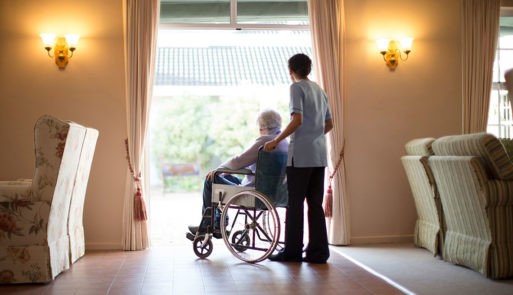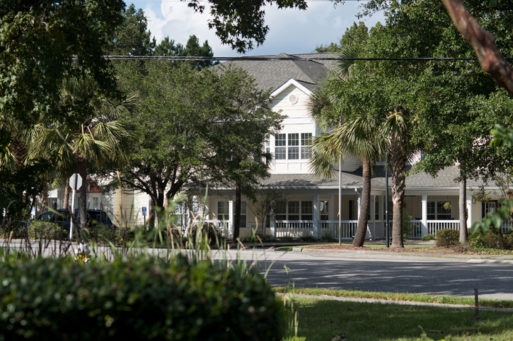With the number of elderly persons with Alzheimer’s disease and dementia increasing each year, the need for specialized facilities to care for them has increased with dizzying speed. Forty percent of people in assisted living facilities in the United States have a diagnosis of dementia, according to a recent article in HuffPost. And of the nearly 30,000 assisted living facilities in the U.S., nearly half care only for people with dementia or offer memory care units devoted to their care. Yet many of these facilities have inadequate numbers of trained staff to provide the kind of specialized care dementia patients require. And, all too often, tragedies happen as a result.

Credit: aarp.org
Case in point: In 2016, a 90-year-old woman named Bonnie Walker wandered away from her assisted living facility in South Carolina in the middle of the night. It was the second time she had done so in several days. The first time she was found and returned safely to her room. But the second time no one noticed she was gone for seven hours. She was found dead in a nearby pond, partially devoured by an alligator.
A terrible accident, certainly. But no more tragic than the many falls, injuries and assaults that occur in assisted living facilities across the United States each year. Unlike nursing homes, assisted living facilities are not licensed by the federal government, nor does the government publish quality ratings for these facilities as it does for nursing homes. Oversight is left to the states, whose rules vary widely and are unevenly enforced.
For example, according to one study from 2016, some states require between two and 30 hours of specialized training for staff caring for people with dementia, while some states require no additional training at all. Additionally, only 19 states set minimum staffing ratios for assisted living facilities. The other 31 allow facilities to make their own staffing rules.
Violations Common
Even in states with robust regulations, violations are common, according to HuffPost. In California, 45 percent of assisted living facilities inspected by the state were cited for at least one violation over the past five years. And in Florida, just under 10 percent of those inspected since 2013 failed to provide enough supervision to prevent dementia patients from wandering away.

Brookdale Charleston, the assisted living facility where Bonnie Walker died
Credit: Leigh Weber via KHN
And a year after Bonnie Walker’s death, the South Carolina Department of Health and Environmental Control cited Brookdale Charleston, the assisted living facility where she died, for 11 violations, including failing to perform nighttime bed checks and inadequate staffing.
The fine was $6,400.
“I worked as a law enforcement agent for the Department of Natural Resources,” said Walker’s granddaughter, Stephanie Weaver, in a statement to HuffPost. “And I’ve written wildlife tickets larger than what DHEC did,” she said.
Competing Priorities
At the heart of the issue, say some industry experts, are competing priorities. Over 80 percent of the nation’s residential care facilities are for-profit entities, and for many of these facilities, the bottom line conflicts with patient needs. According to Fred Steele, Oregon’s long-term care ombudsman, many facilities set staffing ratios that “are more about the bottom line of their profits” than providing optimal care.
At the same time, memory care units and facilities that specialize in dementia care charge more than regular assisted living facilities or nursing homes. According to data from the National Investment Center for Senior Housing & Care, the monthly cost for these specialized facilities averages $6,472, while an ordinary assisted living facility costs an average of $4,835 per month. Further, these facilities are enormously profitable. According to Burnham Mace, the chief economist at the NIC, senior housing has earned investors an annual return of about 15 percent over the last five years — higher than other real estate properties such as apartments and hotels. And the fastest growing sector in the senior housing industry is memory care.
A Difficult Balance
But caring for dementia patients is enormously challenging, says Lindsay Schwartz, associate vice president at the National Center for Assisted Living. While safety is a priority, residents must also have some degree of freedom and an opportunity to socialize. “Freedom of movement is incredibly important for overall health, mind, body and spirit,” she said. “You can’t keep people in isolation.”

Credit: alzheimers.net
At the same time, many facilities use psychotropic drugs to keep wandering or aggressive patients in line. Although the use of chemical restraints in the elderly for any non-medical reason is strictly prohibited by federal law, a recent study published in the Journal of Post-Acute and Long-Term Care Medicine showed that nearly 38 percent of dementia patients in assisted living facilities received antipsychotic drugs. A second study currently underway at the University of North Carolina/Chapel Hill reveals similar prescribing patterns as well as little documentation in patients’ charts justifying antipsychotic use.
These drugs are potentially dangerous in themselves, says Sheryl Zimmerman, a Kenan Distinguished Professor in UNC’s School of Social Work and the lead author of the study. They carry a “black box warning” mandated by the FDA, due to “a significant risk of serious or life-threatening adverse effects, including the risk of a heart attack or stroke,” she said. “… It’s imperative that these communities not only better understand what they’re prescribing, but that they also consider other alternatives before prescribing antipsychotics,” she added.
In fact, according to Zimmerman, what assisted living facilities need is more, and more appropriately trained staff. “All of the things that we used to talk about in nursing homes are the things that we should be talking about in assisted living today,” she said. “Ultimately, older adults, especially older adults with dementia, deserve the best care, and our hope is that over the next five years, our work will lead to changes that improve their chances of having the best quality of life.”
I hope she’s right.

 Are Assisted Living Facilities Understaffed and Dangerous?
Are Assisted Living Facilities Understaffed and Dangerous?


 How Dare You Die Now!
How Dare You Die Now!

 “Help Me, Helen”
“Help Me, Helen”














